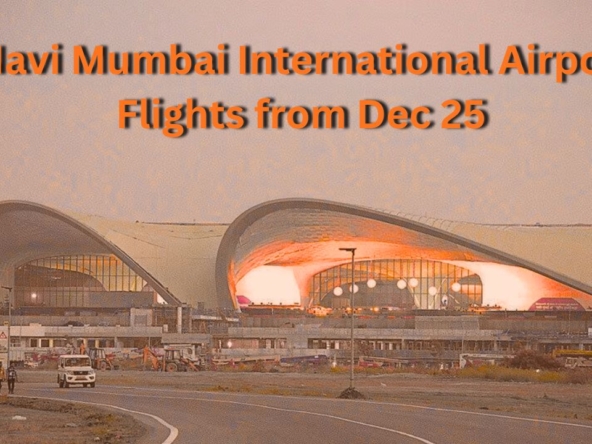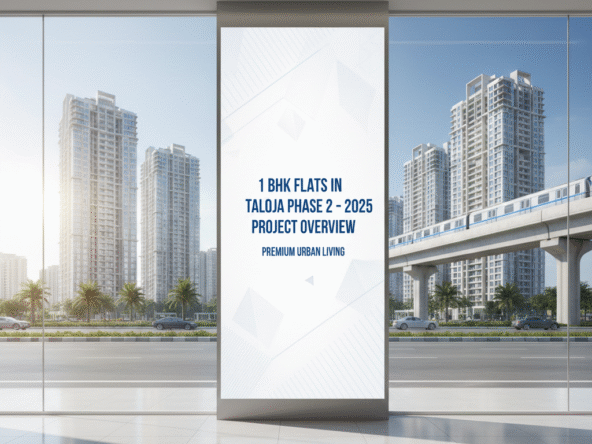Navi Mumbai is no longer “the future city.”
In 2025, it becomes India’s most transformative urban destination.
- 🌍 1. Navi Mumbai Airport Opening Timeline – The Reality in 2025
- 🚇 2. Connectivity: A World-Class Multimodal Transport Hub
- 🏙️ 3. Why Navi Mumbai Airport Will Change the Real Estate Landscape Forever
- ✈️ 4. Luxury, Architecture & Design – A Landmark Airport for India
- 💼 5. Job Creation & Business Opportunities
- 🏡 6. Best Locations to Invest Near Navi Mumbai Airport (2025 List)
- 🏆 7. Why 2025 Is the Best Year for Real Estate Investment in Navi Mumbai
- 🏠 8. NayeGhar.com – Your Trusted Guide for Navi Mumbai & Airport-Area Properties
- ⭐ Conclusion: A New Era for Navi Mumbai Begins in 2025
- 1. When will the Navi Mumbai International Airport open?
- 2. Who is developing the Navi Mumbai Airport?
- 3. How many passengers will the airport handle?
- 4. What will be the impact on real estate near the airport?
- 5. Is the airport connected to Mumbai via the MTHL sea bridge?
- 6. Will the Navi Mumbai Metro connect directly to the airport?
- 7. Which are the best areas to invest near the airport?
- 8. How many jobs will the new airport generate?
- 9. Will property rental demand increase after the airport opens?
- 10. Why is 2025 considered the best year to invest?
The much-awaited Navi Mumbai International Airport (NMIA)—developed by Adani Group—is set to redefine the economic map of Mumbai, Navi Mumbai, Raigad, and India’s aviation infrastructure. With world-class design inspired by the lotus flower, cutting-edge sustainability features, and seamless intermodal connectivity, NMIA promises to be more than just an airport—it is a $2.5 billion gateway to global prosperity.
In this detailed guide, we explore the confirmed opening dates, connectivity plans, impact on real estate prices, investment hotspots, and why 2025 is the strongest year ever to invest around the upcoming airport.
🌍 1. Navi Mumbai Airport Opening Timeline – The Reality in 2025
As per the latest development updates from government authorities and project monitoring agencies, the first phase of Navi Mumbai International Airport is expected to be operational in 2025.
Key Milestones for 2025:
- ✔ Runway 1 construction nearing completion
- ✔ Terminal 1 structure in final stages
- ✔ ATC tower activity started
- ✔ Metro connectivity work accelerated
- ✔ Internal road network ready
- ✔ Electrical & utility systems being installed
Once Phase 1 opens, the airport will handle 10 million passengers annually, eventually expanding to 90 million passengers—making it one of the largest airports in Asia.
🚇 2. Connectivity: A World-Class Multimodal Transport Hub
NMIA is designed to be India’s most connected airport with:
⭐ A. Navi Mumbai Metro Line 1 & 2
Direct connectivity to:
- Kharghar
- Taloja
- Pendhar
- MIDC
- Panvel
Future metro extension will connect Ulwe, Dronagiri, and the airport terminal.
⭐ B. Mumbai Trans Harbour Link (MTHL)
Just 10–15 minutes from the airport to Mumbai via India’s longest sea bridge.
This alone increases property potential by 30–40% over the next few years.
⭐ C. Coastal Road (Planned)
High-speed seamless road connecting Mumbai → NMIA → Alibaug.
⭐ D. Virar–Alibaug Multi-Modal Corridor
Will connect:
- Virar
- Bhiwandi
- Taloja
- Kharghar
- Panvel
- Airport
- Alibaug
This will become the biggest driver of real estate appreciation.
⭐ E. New Rail Terminal (Panvel Junction Upgrade)
Panvel will become the next major railway hub of the Mumbai Metropolitan Region.
🏙️ 3. Why Navi Mumbai Airport Will Change the Real Estate Landscape Forever
The airport is a once-in-a-century infrastructure event—like Bandra Worli Sea Link or Delhi Airport Terminal 3—which permanently transforms land values.
📈 Expected Price Appreciation 2025–2030
| Location | Current Avg Price | 2030 Expected | Growth |
|---|---|---|---|
| Ulwe | ₹6,000–8,000/sqft | ₹14,000–17,000/sqft | 90–120% |
| Dronagiri | ₹4,000–6,000/sqft | ₹9,000–12,000/sqft | 100–150% |
| Panvel | ₹6,000–9,000/sqft | ₹12,000–15,000/sqft | 60–80% |
| Kharghar | ₹11,000–14,000/sqft | ₹17,000–22,000/sqft | 40–60% |
| Taloja Phase 2 | ₹5,000–7,000/sqft | ₹10,000–13,000/sqft | 70–90% |
Real estate demand will be influenced by:
- New jobs (airport, hospitality, logistics, retail)
- Commercial hubs shifting towards Navi Mumbai
- MNCs setting up offices near the airport
- Tourism boost
- Increased international connectivity
✈️ 4. Luxury, Architecture & Design – A Landmark Airport for India
Navi Mumbai International Airport is being designed as:
🌸 A Lotus-Inspired Architectural Icon
The structure draws inspiration from the national flower lotus—symbolizing purity, harmony, and world-class Indian engineering.
🌿 A Sustainable Airport
- Solar-powered terminals
- Rainwater harvesting
- Green energy systems
- Zero-water-discharge design
- Natural cooling architecture
💎 Premium Shopping & Hospitality Zones
Expect a global-class environment:
- International luxury brands
- High-end restaurants
- Premium lounges
- Airport hotels
- Business centers
💼 5. Job Creation & Business Opportunities
The airport is expected to generate:
✔ 2 Lakh+ direct & indirect jobs in:
- Aviation
- Ground staff
- Hospitality
- Security
- Logistics
- Travel agencies
- Retail
- Malls & food courts
Logistics hubs, warehousing complexes, and office parks will flourish around Ulwe, Dronagiri, and Panvel.
🏡 6. Best Locations to Invest Near Navi Mumbai Airport (2025 List)
High-growth zones with massive demand:
⭐ 1. Ulwe
Closest to airport
Metro + MTHL + Coastal Road
Perfect for investors & NRIs
⭐ 2. Dronagiri
Low rates today
Huge appreciation potential
New infra & port connectivity
⭐ 3. Kharghar
Premium area
Metro + Central Park + ISKCON Temple
High-end lifestyle
⭐ 4. Taloja Phase 2
Affordable + Metro connectivity
Ideal for first-time buyers
⭐ 5. Panvel
New Airport City
Biggest commercial boom ahead
Connectivity hub (rail, road, metro)
🏆 7. Why 2025 Is the Best Year for Real Estate Investment in Navi Mumbai
✔ Airport Opening → Price Surge
✔ Metro Expansion → Incredible connectivity
✔ MTHL Bridge → Mumbai travel becomes 15 minutes
✔ Commercial Growth → Job-driven housing demand
✔ Low prices today → High returns guaranteed
If someone buys property in 2025, they will be 3–5X ahead of the market by 2030.
🏠 8. NayeGhar.com – Your Trusted Guide for Navi Mumbai & Airport-Area Properties
At NayeGhar.com, we help buyers find properties that match:
✓ Budget
✓ Location
✓ Metro connectivity
✓ Airport distance
✓ Rental yield potential
✓ RERA-verified projects
You get:
- FREE Property Search
- FREE Project Comparisons
- FREE Site Visits
- 0% Brokerage on many projects
👉 Send your Budget + Location on WhatsApp to get a curated shortlist instantly.
⭐ Conclusion: A New Era for Navi Mumbai Begins in 2025
The Navi Mumbai International Airport is more than a global gateway—
it is the epicenter of the next real estate revolution in Maharashtra.
2025 is the turning point where:
- connectivity multiplies,
- employment grows,
- and property values rise dramatically.
Whether you’re a first-time homebuyer, investor, or NRI, this is the perfect time to secure your future in India’s fastest-growing smart city.
1. When will the Navi Mumbai International Airport open?
The first phase of Navi Mumbai International Airport is expected to open in 2025, with one runway and Terminal 1 becoming operational for domestic and limited international flights.
2. Who is developing the Navi Mumbai Airport?
The airport is being developed by Adani Group in partnership with CIDCO, following a world-class masterplan inspired by the lotus flower.
3. How many passengers will the airport handle?
Phase 1 will handle 10 million passengers per year, expanding to 90 million passengers across all phases—making it one of Asia’s largest airports.
4. What will be the impact on real estate near the airport?
Areas like Ulwe, Dronagiri, Panvel, Kharghar, and Taloja are expected to see 40–120% price appreciation between 2025–2030 due to connectivity, job creation, and infrastructure projects.
5. Is the airport connected to Mumbai via the MTHL sea bridge?
Yes. The Mumbai Trans Harbour Link (MTHL) will connect Mumbai to Navi Mumbai in 15–20 minutes, boosting residential demand near the airport.
6. Will the Navi Mumbai Metro connect directly to the airport?
Future metro extensions from Taloja Line 1 and Kharghar Line 2 are planned to provide seamless connectivity directly to the airport terminal.
7. Which are the best areas to invest near the airport?
Top investment hotspots include Ulwe, Dronagiri, Panvel, Kharghar, and Taloja Phase 2 due to their affordability, connectivity, and rapid development.
8. How many jobs will the new airport generate?
Over 2 lakh+ direct and indirect jobs are expected in aviation, logistics, hospitality, metro operations, retail, and commercial sectors.
9. Will property rental demand increase after the airport opens?
Yes. Rental demand will rise significantly in areas like Ulwe, Panvel, Kharghar, especially among airport staff, airline crew, and corporate professionals.
10. Why is 2025 considered the best year to invest?
Because prices are still relatively low, and major infrastructure—airport, metro, MTHL—is nearing completion.
Buying in 2025 gives maximum appreciation potential before price hikes begin in 2026–2027.





